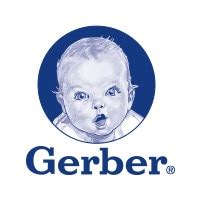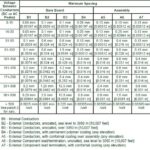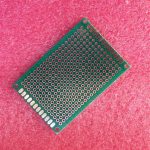What is Gerber?
Gerber is a generic term that refers to a family of file formats used to represent PCB designs. The original Gerber format, RS-274D, was a numerical control (NC) format used to control vector photoplotters for PCB production. Over time, the format evolved to include aperture information and became known as Standard Gerber or Gerber RS-274X.
Advantages of Gerber Format
- Industry standard for PCB design data exchange
- Simple ASCII-based format
- Compact file size compared to other PCB design formats
- Compatible with a wide range of PCB design software and manufacturing equipment
RS-274X File Structure
An RS-274X file consists of a sequence of commands and coordinates that describe the PCB layout. Each command is represented by a single letter or symbol, followed by its associated parameters.
Command Format
| Command | Description |
|---|---|
| D01 | Draw line |
| D02 | Move tool |
| D03 | Flash aperture |
| G01 | Linear interpolation |
| G02 | Clockwise circular interpolation |
| G03 | Counterclockwise circular interpolation |
| G04 | Comment |
| G36 | Begin polygon area fill |
| G37 | End polygon area fill |
| G74 | Single quadrant circular interpolation |
| G75 | Multi-quadrant circular interpolation |
| M02 | End of program |
Coordinate Format
Coordinates in an RS-274X file are represented using the format:
X#####Y#####
Where ##### represents the X or Y coordinate value, respectively. The coordinate values are integers and are typically expressed in units of 1/10,000th of an inch or 1/100,000th of a millimeter.
Aperture Definitions
RS-274X introduces the concept of apertures, which define the shape and size of the tool used to draw the PCB features. Apertures are defined using the AD command followed by the aperture number and its parameters.
%ADD10C,0.5*%
In this example, aperture number 10 is defined as a circle (C) with a diameter of 0.5 units.
Layers in RS-274X
A complete PCB design is typically represented by multiple RS-274X files, each corresponding to a specific layer of the board. Common layer types include:
- Top and bottom copper layers
- Solder mask layers
- Silkscreen layers
- Drill and route layers
Each layer is usually stored in a separate file with a specific file extension that identifies its layer type.
| Extension | Layer Type |
|---|---|
| .GTL | Top copper layer |
| .GBL | Bottom copper layer |
| .GTS | Top solder mask |
| .GBS | Bottom solder mask |
| .GTO | Top silkscreen (overlay) |
| .GBO | Bottom silkscreen (overlay) |
| .GKO | Board outline |
| .GPT | Top pad master |
| .GPB | Bottom pad master |
| .GD1 | Drill drawing |
| .GG1 | Drill guide |

Creating RS-274X Files
Most PCB design software packages can generate RS-274X files as output. The process typically involves:
- Designing the PCB layout using the software’s built-in tools
- Specifying the output settings, such as unit format, aperture list, and file extensions
- Generating the RS-274X files for each layer
Some popular PCB design software that supports RS-274X output include:
- Altium Designer
- KiCad
- Eagle
- OrCAD
- Cadence Allegro
Viewing and Editing RS-274X Files
While RS-274X files are plain text and can be viewed in any text editor, specialized Gerber Viewers provide a more user-friendly way to visualize and inspect the PCB layout. Some popular Gerber viewers include:
- GerbView (included with KiCad)
- ViewMate
- CAM350
- GC-Prevue
These viewers allow you to load multiple RS-274X files, display them in different colors, and inspect the design for errors or manufacturing issues.
Editing RS-274X files directly is not recommended, as it can introduce errors that may result in manufacturing problems. If changes to the PCB design are necessary, it is best to make them in the original PCB design software and regenerate the RS-274X files.
Gerber File Validation
Before sending RS-274X files to a PCB manufacturer, it is essential to validate them for errors and manufacturability. Common issues to look for include:
- Missing or incorrect aperture definitions
- Overlapping or self-intersecting traces
- Clearance violations
- Incomplete or missing layers
Many PCB Manufacturers provide online Gerber file validators that can check for these issues and provide feedback on how to correct them. Some popular online Gerber validators include:
- PCBWay Gerber Viewer
- EasyEDA Gerber Viewer
- Seeed Studio Gerber Viewer
Best Practices for RS-274X
To ensure smooth PCB manufacturing and avoid common issues, follow these best practices when working with RS-274X files:
- Use a consistent unit format (imperial or metric) throughout your design
- Provide a complete set of RS-274X files for all necessary layers
- Include an aperture list file (
.apr) that defines all apertures used in the design - Ensure that all files use the same coordinate origin and orientation
- Validate your files using a Gerber viewer or online validator before submitting them for manufacturing
FAQ
1. What is the difference between RS-274D and RS-274X?
RS-274D is the original Gerber format used for vector photoplotters, while RS-274X is an extended version that includes aperture definitions and additional commands for improved PCB design representation.
2. Can I use RS-274X files for PCB Assembly?
While RS-274X files primarily represent the PCB layout, they do not contain all the information needed for assembly, such as component placement and orientation. For assembly purposes, additional files like pick-and-place and bill of materials (BOM) are required.
3. Are RS-274X files compatible with all PCB manufacturers?
Most PCB manufacturers support RS-274X as the standard format for PCB design data exchange. However, it is always a good idea to check with your specific manufacturer for their file format requirements and any additional files they may need.
4. Can I combine multiple RS-274X files into a single file?
While it is possible to combine multiple RS-274X files into a single file, it is generally not recommended. Each file typically represents a specific layer of the PCB, and combining them can lead to confusion and errors during manufacturing.
5. How can I ensure my RS-274X files are error-free?
To minimize the risk of errors in your RS-274X files:
- Use a reliable PCB design software to create your layout
- Double-check your output settings before generating the files
- Validate your files using a Gerber viewer or online validator
- Carefully review your design for any issues or manufacturability concerns
By following these best practices and working closely with your PCB manufacturer, you can ensure that your RS-274X files accurately represent your PCB design and lead to a successful manufacturing process.






Leave a Reply